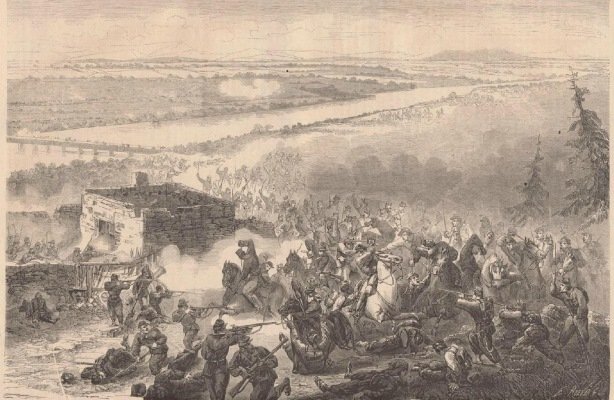
The Battle of Front Royal
May 23, 1862
“The opposing Marylanders were equally anxious to kill each other.”
At the Battle of Front Royal, Confederate Gen. Stonewall Jackson surprised and destroyed an isolated Union garrison, unhinging the Federal defenses in the Valley – and forcing the Union garrison at Strasburg to race north towards Winchester to avoid being cut off.
Stonewall Moves North
Following his victory at McDowell on May 8, 1862, Stonewall Jackson returned his army to the Shenandoah Valley and set his sights on Gen. Nathaniel P. Banks’ command, which defended a line from Strasburg to Front Royal. In an effort to destroy Banks and sever his line of supply and communication along the Manassas Gap Railroad, Jackson determined to strike Banks’ eastern flank at Front Royal defended by approximately 1,000 men commanded by Marylander Col. John R. Kenly. On May 21, Stonewall Jackson marched through New Market, then darted east through the New Market Gap in Massanutten Mountain into the Luray Valley. There he united with troops under Gen. Richard Ewell and hurried north with the combined force.
The Battle of Front Royal
As Jackson approached Front Royal on May 23 he learned that the town’s primary defenders consisted of Col. John R. Kenly’s 1st Maryland Infantry. Immediately Jackson summoned Col. Bradley Johnson, who commanded the 1st Maryland Infantry (C.S.A.), and ordered his force to lead the attack.
Despite being heavily outnumbered by Jackson’s army, Kenly formed a defensive line on Richardson’s Hill and held back the Confederates for almost two hours. When rebel cavalry approached from the west, threatening to cut him off, Kenly was forced to retreat across the South and North Forks of the Shenandoah River. After crossing, he attempted to burn the bridges behind him (Union Sgt. William Taylor would earn the Medal of Honor for his actions during the attempt), cutting off pursuit, but the fires were soon extinguished.
“We drove them through the town, all the time howling like demons.”
Belle Boyd
As the Confederates approached Front Royal, resident and southern spy Belle Boyd ran to greet southern officers, “Go back quick and tell [Stonewall Jackson] that The Yankee force is very small…” she reported. “Tell him to charge right down, and he will catch them all.”
Sensing Kenly might escape, Jackson ordered Lt. Col. Thomas S. Flournoy’s 6th Virginia Cavalry to pursue. The Virginia horsemen caught up with Kenly approximately three miles north of Front Royal at Cedarville.
After a brief fight, Flournoy’s troopers devastated Kenly’s command. Jackson’s army inflicted 900 casualties on the Federals, 700 of whom were captured. The victory not only wiped out the Federal outpost – it opened up the possibility of cutting off and destroying the rest of Gen. Nathaniel Banks command at Strasburg.
“They closed in upon us, literally cutting us up to pieces, the men fighting desperately.”
The Race for Winchester
In Strasburg, Union commander Gen. Nathaniel Banks received conflicting and confusing reports of what had happened in Front Royal. When the extent of the Confederate victory at Front Royal – and the size of the rebel force – became clearer, Banks believed that his best option was “to enter the lists with the enemy in a race of a battle, as he should choose, for possession of Winchester, the key of the Valley, and for us the position of safety.” The next morning, Banks started towards Winchester – and the “race” was on.






